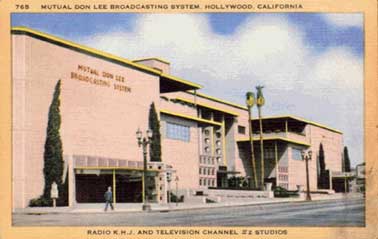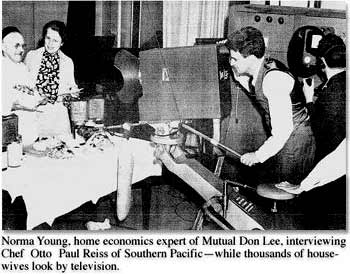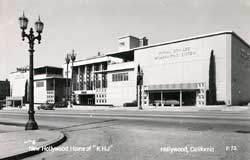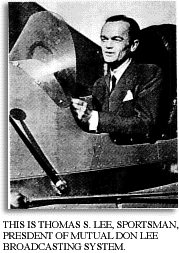Don Lee Mutual Broadcasting Building
To Become Academy Film Archive
 Hollywood’s
oldest surviving studio building designed specifically for television broadcasting,
at 1313 Vine Street was purchased by the Academy of Motion Picture Arts and
Sciences to house the Academy Film Archive. The adaptive reuse of this historic
structure is applauded as a return to Hollywood for the Academy, whose first
offices were at 6912 Hollywood Boulevard. The Academy Awards, which were first
presented at the Hollywood Roosevelt Hotel in 1929, will also be returning
to Hollywood this year when they are presented in the new Kodak Theatre at
the Hollywood & Highland project. Though the Academy does not own this
space, they have signed a long-term lease to present the Awards there.
Hollywood’s
oldest surviving studio building designed specifically for television broadcasting,
at 1313 Vine Street was purchased by the Academy of Motion Picture Arts and
Sciences to house the Academy Film Archive. The adaptive reuse of this historic
structure is applauded as a return to Hollywood for the Academy, whose first
offices were at 6912 Hollywood Boulevard. The Academy Awards, which were first
presented at the Hollywood Roosevelt Hotel in 1929, will also be returning
to Hollywood this year when they are presented in the new Kodak Theatre at
the Hollywood & Highland project. Though the Academy does not own this
space, they have signed a long-term lease to present the Awards there.
The Academy expects to move in the Film Archive and the Players Directory offices and a portion of the archive’s holdings by year’s end, with the balance of the work to be completed later in 2002. Renovation of the building is being designed and supervised by architect and Hollywood Heritage board member Fran Offenhauser, whose designs for the Academy’s Center for Motion Picture Study in Beverly Hills, the present home of the Academy Film Archive and the Margaret Herrick Library, won national awards for adaptive reuse.
The Don Lee Mutual Building at 1313 Vine is an 118,000 square-foot building that was officially dedicated on August 18, 1948 as a state-of-the-art broadcast facility for radio and television. It was the culmination of a broadcasting dynasty begun by Don Lee, who held the franchises for California and Nevada Cadillac dealerships, fostered Los Angeles radio, and was a leading pioneer of television on the West Coast.
 1313
Vine was designed by veteran architect Claude Beelman (1884-1963), whose Art
Deco commercial building designs included the Eastern-Columbia building (1929)
and Garfield building (1930) in downtown Los Angeles, the A. J. Heinsbergen
Decorating Co. on Beverly Boulevard (1925), the Hollywood Branch Post Office
(1937), Hollywood Theater (1938 remodeling), and the Metro-Goldwyn-Mayer Administration
“Thalberg” building (1938).
1313
Vine was designed by veteran architect Claude Beelman (1884-1963), whose Art
Deco commercial building designs included the Eastern-Columbia building (1929)
and Garfield building (1930) in downtown Los Angeles, the A. J. Heinsbergen
Decorating Co. on Beverly Boulevard (1925), the Hollywood Branch Post Office
(1937), Hollywood Theater (1938 remodeling), and the Metro-Goldwyn-Mayer Administration
“Thalberg” building (1938).
The Vine Street complex was loosely characterized as “South American contemporary design” in a trade magazine of the period. A unique feature of the design was the incorporation of large display windows on the Vine Street projecting bays. Though the building was never used for selling Cadillacs, the windows provided direct advertising for the latest models of the owner’s other business.
 The
$3,000,000 block-square building featured four large “Auditorium” type sound
stages designed for audience participation or symphony orchestra shows, with
stage room for more than 100 musicians and an audience of 350 people each.
The studios were designed as individual units within a larger structure so
walls were not shared, allowing for optimal soundproofing. These larger studios
were also designed to permit simultaneous television broadcast. The facility
also included four large “Dramatic” type studios in which a great variety
of radio shows requiring fewer people could be presented, three small studios
allowing for commentary or group discussion-type programming, and three announce
booths which included transcription equipment. The lobby proudly displayed
a massive master control board behind a plate glass wall, which allowed visitors
to watch the network controller at work.
The
$3,000,000 block-square building featured four large “Auditorium” type sound
stages designed for audience participation or symphony orchestra shows, with
stage room for more than 100 musicians and an audience of 350 people each.
The studios were designed as individual units within a larger structure so
walls were not shared, allowing for optimal soundproofing. These larger studios
were also designed to permit simultaneous television broadcast. The facility
also included four large “Dramatic” type studios in which a great variety
of radio shows requiring fewer people could be presented, three small studios
allowing for commentary or group discussion-type programming, and three announce
booths which included transcription equipment. The lobby proudly displayed
a massive master control board behind a plate glass wall, which allowed visitors
to watch the network controller at work.
Don Lee controlled twelve West Coast radio stations forming a regional network. This pacific network provided and shared programming with the Chicago-based Mutual network, but retained a great deal of independence. Lee, who died in 1934, began purchasing radio stations in the mid-‘20s when Earl Anthony, the Packard dealer and Lee’s main competitor, purchased KFI to advertise his automobiles. Lee commissioned the first Los Angeles television broadcasts in 1929 and presented the first motion picture to be broadcast on television, The Crooked Circle, simultaneous with its release in 1932. Upon his death the company retained his name and Thomas, his son, handled much of the radio and Cadillac business over to associates. Thomas retained a strong interest in television, however, and by 1939 had built the first TV studio in Los Angeles (now demolished) atop the self-anointed Mount Lee, directly above the Hollywood sign. It was from here that many pioneer programs, including the first Rose Parade broadcast, were transmitted.
 In
1945 when the Don Lee Company purchased the land on Vine Street for the new
studio, it was a prime force in radio and the technical leader in television.
By the 1948 opening, their television leadership was already being eroded
by KTLA’s local programming savvy and the national broadcast networks. The
building wasn’t even finished, in fact, before CBS was renting additional
radio studio space, as its Sunset Boulevard studios were overflowing. Prior
to the Vine Street building's completion, Don Lee had headquartered above
the Cadillac dealership downtown, and later at 5515 Melrose Avenue. The opening
of the new building placed the West Coast radio broadcast facilities of ABC,
CBS, Mutual, and NBC all within walking distance of each other near Vine and
Sunset. Only the Don Lee building and CBS studios remain, with CBS the only
facility still broadcasting.
In
1945 when the Don Lee Company purchased the land on Vine Street for the new
studio, it was a prime force in radio and the technical leader in television.
By the 1948 opening, their television leadership was already being eroded
by KTLA’s local programming savvy and the national broadcast networks. The
building wasn’t even finished, in fact, before CBS was renting additional
radio studio space, as its Sunset Boulevard studios were overflowing. Prior
to the Vine Street building's completion, Don Lee had headquartered above
the Cadillac dealership downtown, and later at 5515 Melrose Avenue. The opening
of the new building placed the West Coast radio broadcast facilities of ABC,
CBS, Mutual, and NBC all within walking distance of each other near Vine and
Sunset. Only the Don Lee building and CBS studios remain, with CBS the only
facility still broadcasting.
Early Don Lee programming produced in the Vine Street facility included Queen For A Day, The Bill Stulla Show, Heart’s Desire, Don Lee Music Hall, Peter Potter’s Party, and The Jack Kirkwood Show. The building housed the Don Lee Network administrative offices and studios. CBS rented the studios on the north half, and in the early fifties began television production there. CBS’s Channel Two, KNXT, was housed there until the early ‘60s and produced many of its earliest local programs including The Big News, Carson’s Cellar (Johnny Carson’s pre-Tonight Show program), and before Television City was completed, network broadcasts of My Friend Irma, among others.
In the early ‘60s CBS consolidated Channel Two into its radio facilities at Columbia Square and the remnants of Don Lee consolidated with RKO at its KHJ offices on Melrose. Shortly thereafter an early pay television experiment, Skyatron, had offices there. In 1964, California Community Television, which became KCET, occupied the northern half of the studios. They remained there until 1971 and produced the Emmy-award winning television movie The Andersonville Trial on the northeast stage. The early ’70s began the ABC era, with Barney Miller and The Joey Bishop Show produced there and the 1984 Olympic Games coverage headquartered there. During the 90’s the facility housed the Aids Project LA offices and operations.